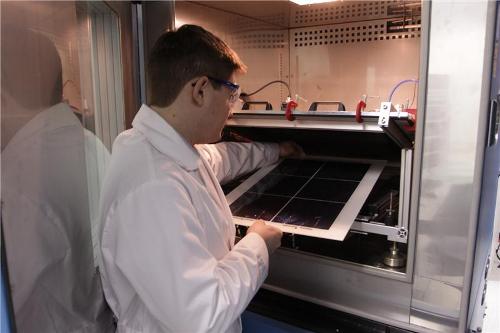Photovoltaic modules are environment- and climate-friendly sources of power. However since these are expensive, it is important that these modules last long for at least more than 25 years. U.S. Fraunhofer researchers are now studying materials that can keep solar cells safe from environmental influence in order to meet that objective.

In this mechanical test stand the researcher examines the quality of silicone-encased
solar modules. (© Fraunhofer CSE)
Silicone, which is neither an organic polymer nor an inorganic crystal though related to both, is a highly unusual substance. PV modules are encapsulated with silicones but are not used for the lamination of solar modules. Presently, ethyl vinyl acetate or EVA is used for the purpose.
Researchers from Dow Corning and Fraunhofer collaborated in order to determine whether EVA can be replaced by silicone. Photovoltaic cells were coated with liquid silicone. The silicone hardens, encasing the cells and thus provides optimal protection. CSE Experts built prototypes from the cells laminated by silicone and studied these photovoltaic modules in a climate chamber under cyclic temperature and at low temperature. The module performance was then tested using a light flasher. Furthermore, electro-luminescence imaging was used to detect micro-cracks. These results when compared with presently-used solar modules showed that photovoltaic modules encased by silicone are highly resistant to cyclic loading such as the kind experienced in strong winds, especially at-40°C
Meanwhile, these tests have been published in the 26th European Photovoltaics Solar Energy Conference in 2011.
Disclaimer: The views expressed here are those of the author expressed in their private capacity and do not necessarily represent the views of AZoM.com Limited T/A AZoNetwork the owner and operator of this website. This disclaimer forms part of the Terms and conditions of use of this website.